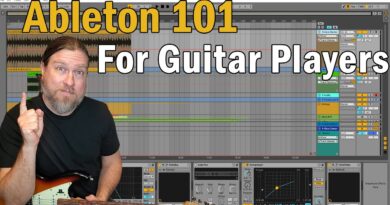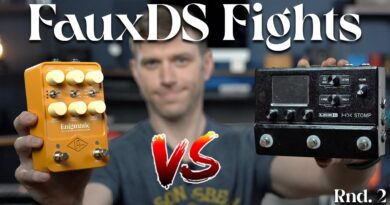DIY Zendrive for £15: Build Robben Ford’s Favorite Pedal
Can you build Robben Ford’s favourite pedal, the Zendrive, for just £15? ???? In this video, I’ll show you how to recreate the legendary Zendrive using a low-cost DIY stripboard kit. With just £15 and some patience, you can craft this iconic overdrive pedal at home and capture the smooth, dynamic tone that Robben Ford loves.
**USA Affiliate links**
Fluke Multimeter – https://amzn.to/407wOwv
Capacitor Tester – https://amzn.to/41NM7LL
Transistor Tester DCA55 – https://amzn.to/3DqzMTD
KNIPEX Snips – https://amzn.to/3ZOtAOf
**UK Affiliate links:**
Fluke Multimeter – https://amzn.to/4gL2RHW
Capacitor Tester – https://amzn.to/3DvrhXG
Transistor tester DCA55 – https://amzn.to/3VSxP91
KNIPEX Snips – https://amzn.to/3CDFSQm
Here’s what you’ll discover:
✅ Step-by-step instructions for building a Zendrive on a stripboard.
✅ How to assemble a pro-quality overdrive pedal for just £15.
✅ A full demo of this legendary build.
If you’ve ever wanted a boutique pedal without the boutique price tag, this video is your gateway to incredible tone on a budget.
Watch now and start building your dream overdrive for next to nothing!
BITSBOX ZENDRIVE KIT – https://www.bitsboxuk.com/index.php?main_page=product_info&products_id=2048
Pedal Sockets – https://shop.pedalparts.co.uk/product/rocketsockets
0:00 – Intro
0:11 – What’s needed
2:39 – StripBoard
11:44 – Resistors
19:32 – Capacitors
25:48 – Transistors
29:31 – Hardware
31:51 – Wiring
37:50 – Knobs
39:36 – Opamps
40:38 – Zendrive achieved?
41:37 – Sound Sample
#DIY #Zendrive #Build #Robben #Fords #Favorite #Pedal
Originally posted by UCuJLugw0PI3HKWjMeAVxSEA at https://www.youtube.com/watch?v=on5i6oRa-DA




Not sure how the algo found this, but really enjoying it as I sit here and finally sort my passive components in to 3d printed drawers. ( it's only taken about 20 years to get organized!). As an ex-pro audio service tech, I think you're mostly pretty spot on, really good advice for beginners, well done.
As for component holding whilst soldering, as another commentator has posted, starting with the low profile stuff like resistors and diodes is a good practise, but when repairing stuff, that's not always an option, so I always kept a packet of blu-tak in the tool box, just use a blob on the component side to hold the part in place. If it gets hot it also has a distinctive smell, so you know if you're heating the part for too long!
I've built one or two of these before, I always think it's kinda funny how there's so little going on in such a huge sound. Fantastic.
Just watch your other hand with that blade lol.
Sounds great; plus you picked the knobs I’d have picked ????. Merry Christmas to you & yours my friend!?!?!
NE5532P – all day long ????????????
Great I love you!!!!!!!!!!!
Great video! I would go with the silver topped knobs for the reasons you mentioned. ????????✨
Looks like they’ve stopped shipping to the US. Bummer.
I was taught to fit all the lowest profile components first. So that the board lays flat when soldering, which holds the components against the board. All diodes in one go, then resistors, IC socket etc.
So cool thank you
There's no shame in using a set of reading glasses at the bench. I have a pair I glued an extra lense from a microscope onto the, "good side" for extra close-up work.
My phone has a "mirror image" flipper thing in the photo editing app- Id bet that most phones have the same feature, I just take a screenshot of the stripboard layout, then mirror-flip the image for cutting the traces in the back- I too need to have things as idiot-proof as possible or I veer into the weeds!
Fuzz Dog.. Much better kit !!
I could have done it for half that price…. ????
Only joking Joe. You did a killer build.
It's a cool circuit. I built a double pedal of this before one side standard and other side modified with switching on clipping section. and value changes, swapping components etc. It makes a versatile little dual pedal in a 1590bb enclosure. Plus, if you wire the 2nd side of the circuit a certain way with an extra cap, you can have it engaged as a always on buffer.
I'm all about those maroon knobs, man.
How much did it actually cost? All up, no BS.
Would have picked the 3rd knobs – brings out the red hair of the girl (and the red of her shoes) better, but maybe it looks different in person.
Another great video mate and props to bits box, I probably get an order a week from them.
Sweet! What I think may be very interesting to your fans would be the Cornish G2 overdrive as used by Dave Gilmour which I presume is another take on the big muff.
It would be also interesting to know which model of the muff it's closest to in sound. Just think a Cornish G2 for less than £50.????
Bitsbox, what a place. I remember ordering shed loads from them when I built a few pedals. I believe they are pretty local too ????
I could teach a monkey to solder better than that.
A1 job, I like the knobs.
Rocket sockets or something here.
You do have to have 100 % confidence in whatever you are using to test your components. Well at least until you understand your circut.
Saw one of the engineers at work using a dremel on those copper lines. Bit overkill.
Great sounding pedal.
Another great build and as for Bitsbox, they are very good but just don't stock enough variety.
Ah a man after my own heart ???? I also use a blade to cut the tracks mate…. But I'm a little more refined I use a No 3 Swann Morton scalpel with a 10A blade ????. And bits box is awesome.
Bits Box! I bought a load of my components from Bob years ago on eBay when it was still Bob's Bits Box when I first got into electronics! I remember him being a really nice guy explaining a few things for me!
Great job Joe, sounds killer
The DMM looks cool but they are expensive ???????????????????????????????????????????????????????? maybe I will get one of santa clause